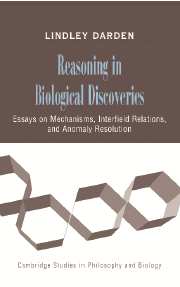 Reasoning in Biological Discoveries
Reasoning in Biological Discoveries Book contents
- Frontmatter
- Contents
- Long Contents
- List of Figures
- List of Tables
- Acknowledgments
- Introduction
- PART I BIOLOGICAL MECHANISMS
- PART II REASONING STRATEGIES: RELATING FIELDS, RESOLVING ANOMALIES
- 5 Interfield Theories with Nancy Maull
- 6 Theory Construction in Genetics
- 7 Relations Among Fields in the Evolutionary Synthesis
- 8 Selection Type Theories with Joseph A. Cain
- 9 Strategies for Anomaly Resolution: Diagnosis and Redesign
- 10 Exemplars, Abstractions, and Anomalies: Representations and Theory Change in Mendelian and Molecular Genetics
- 11 Strategies for Anomaly Resolution in the Case of Adaptive Mutation
- PART III DISCOVERING MECHANISMS: CONSTRUCTION, EVALUATION, REVISION
- Bibliography
- Index
- References
7 - Relations Among Fields in the Evolutionary Synthesis
Published online by Cambridge University Press: 31 August 2009
- Frontmatter
- Contents
- Long Contents
- List of Figures
- List of Tables
- Acknowledgments
- Introduction
- PART I BIOLOGICAL MECHANISMS
- PART II REASONING STRATEGIES: RELATING FIELDS, RESOLVING ANOMALIES
- 5 Interfield Theories with Nancy Maull
- 6 Theory Construction in Genetics
- 7 Relations Among Fields in the Evolutionary Synthesis
- 8 Selection Type Theories with Joseph A. Cain
- 9 Strategies for Anomaly Resolution: Diagnosis and Redesign
- 10 Exemplars, Abstractions, and Anomalies: Representations and Theory Change in Mendelian and Molecular Genetics
- 11 Strategies for Anomaly Resolution in the Case of Adaptive Mutation
- PART III DISCOVERING MECHANISMS: CONSTRUCTION, EVALUATION, REVISION
- Bibliography
- Index
- References
Summary
INTRODUCTION
The synthetic theory of evolution is a multilevel theory that serves to synthesize knowledge from fields at different levels of organization. It provides a solution to the problem of the origin of species. Biologists attempted to solve this problem for years, during which time the key fields emerged and developed to the point that the synthesis was possible. Prior to the synthesis, debate occurred about what components were necessary to solve the problem and alternative theories were proposed. Had any of the prior theories been correct, then the fields that exist within evolutionary studies would have been different. Which fields exist is a contingent fact about the nature of the world and the way we study it. Which fields are synthesized to solve certain problems is contingent on the nature of the solution and the stage of development of various fields at the time the solution is proposed.
Relations among levels of organization, fields of study, and the problem of the origin of species are the subjects of this chapter. The focus is on the synthetic theory of evolution as proposed by Theodosius Dobzhansky in 1937, the multiple levels within it, the knowledge from different fields that it synthesized, and its various predecessors. The final section discusses the concept of a synthetic theory and contrasts that with previously studied interfield theories.
THE SYNTHETIC THEORY
Theodosius Dobzhansky published the seminal book outlining the evolutionary synthesis in 1937: Genetics and the Origin of Species.
- Type
- Chapter
- Information
- Reasoning in Biological DiscoveriesEssays on Mechanisms, Interfield Relations, and Anomaly Resolution, pp. 170 - 181Publisher: Cambridge University PressPrint publication year: 2006


